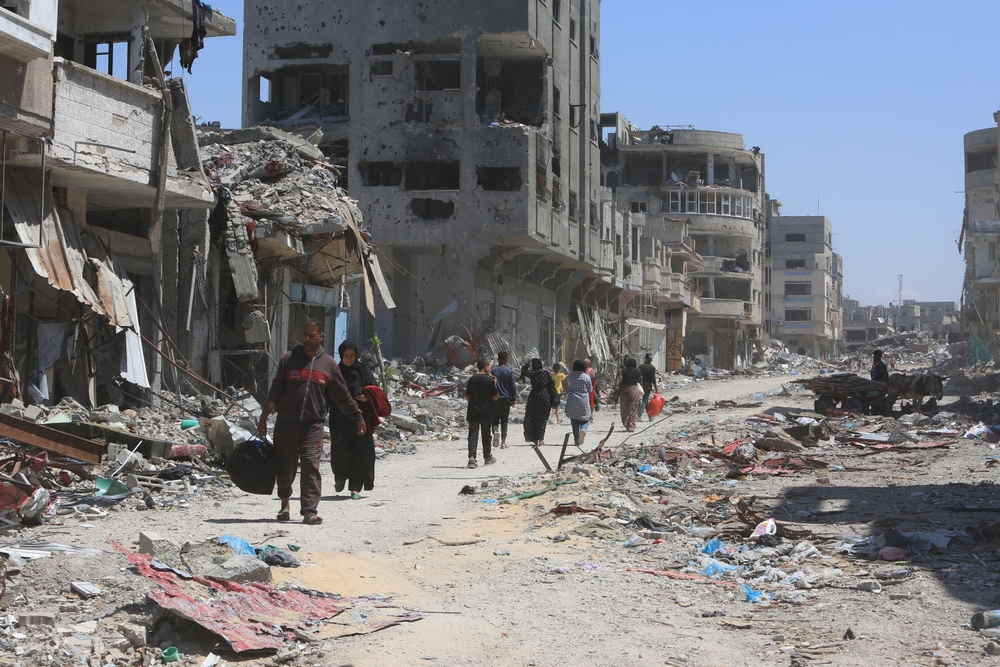After months of war and devastation, tens of thousands of Palestinians returned to northern Gaza under a fragile ceasefire, marking the first time this area has been opened since the early weeks of the conflict. Families, many carrying babies or pushing wheelchairs, streamed back to their homes, defying fears that the exodus from the north might be permanent.
Associated Press footage captured this powerful moment of return, with crowds moving northward well into the evening, observed by Israeli tanks stationed nearby.
A Long-Awaited Homecoming
For many Palestinians, the return was bittersweet. Despite the widespread destruction, the desire to reclaim their homes outweighed the hardship. Yasmin Abu Amshah, a mother of three, walked nearly four miles to reach her damaged but livable home in Gaza City. “It was a long trip, but a happy one,” she shared, adding that she was overjoyed to reunite with her younger sister after more than a year apart.
This act of resilience was seen by many as a statement of steadfastness against displacement. It also served as a rejection of U.S. proposals to resettle Palestinians in neighboring Egypt and Jordan—plans those nations have firmly opposed.
Hostages and the Fragility of Ceasefire
The ceasefire, brokered to end one of the most destructive wars between Israel and Hamas, also aimed to address the release of hostages captured during the October 7, 2023, Hamas attack. Tragically, Israeli spokesman David Mencer confirmed that eight of the hostages on the initial release list were deceased. “The families have been informed,” Mencer stated.
The release of additional hostages, including female soldier Agam Berger, is scheduled in the coming days as part of the ongoing truce negotiations. Defense Minister Israel Katz warned that any violations of the ceasefire or threats to Israeli forces would be met with severe consequences.
Scenes of Destruction and Joy
Despite delays and disputes over the terms of the ceasefire, the reopening of northern Gaza brought moments of jubilation. Ismail Abu Matter, who waited three days to return, described the emotional reunions as people sang, prayed, and wept together. “It’s the joy of return,” he said, reflecting on his family’s resilience since being displaced during the 1948 war.
However, the scene was also marked by sorrow and destruction. The once-bustling neighborhoods are now reduced to rubble, with families struggling to locate the remnants of their homes. “This is our house, four stories. You can’t see them,” one man said, gesturing to the ruins captured in an AP video.
Hope Amid Tensions
The crossing, part of the Netzarim corridor, was initially delayed due to disagreements between Israel and Hamas over the order of hostages to be released. Qatar mediated a resolution, ensuring the release of additional hostages and paving the way for Palestinians to return north.
Hamas hailed the return as a victory, calling it “a declaration of failure and defeat for the [Israeli] occupation and transfer plans.” Meanwhile, Israel remains cautious, inspecting vehicles for weapons and maintaining a buffer zone within Gaza.
The Path Forward
While the ceasefire holds, the challenges ahead are immense. With over 47,000 Palestinians killed in the conflict, according to Gaza’s Health Ministry, and nearly 90% of Gaza’s population displaced, the path to recovery will be long and arduous. Yet, for those returning to the north, this moment symbolizes hope and resilience in the face of overwhelming adversity.
As the ceasefire unfolds and hostages are gradually released, the international community watches closely, hopeful that this fragile truce can lead to lasting peace in a region torn apart by war.


